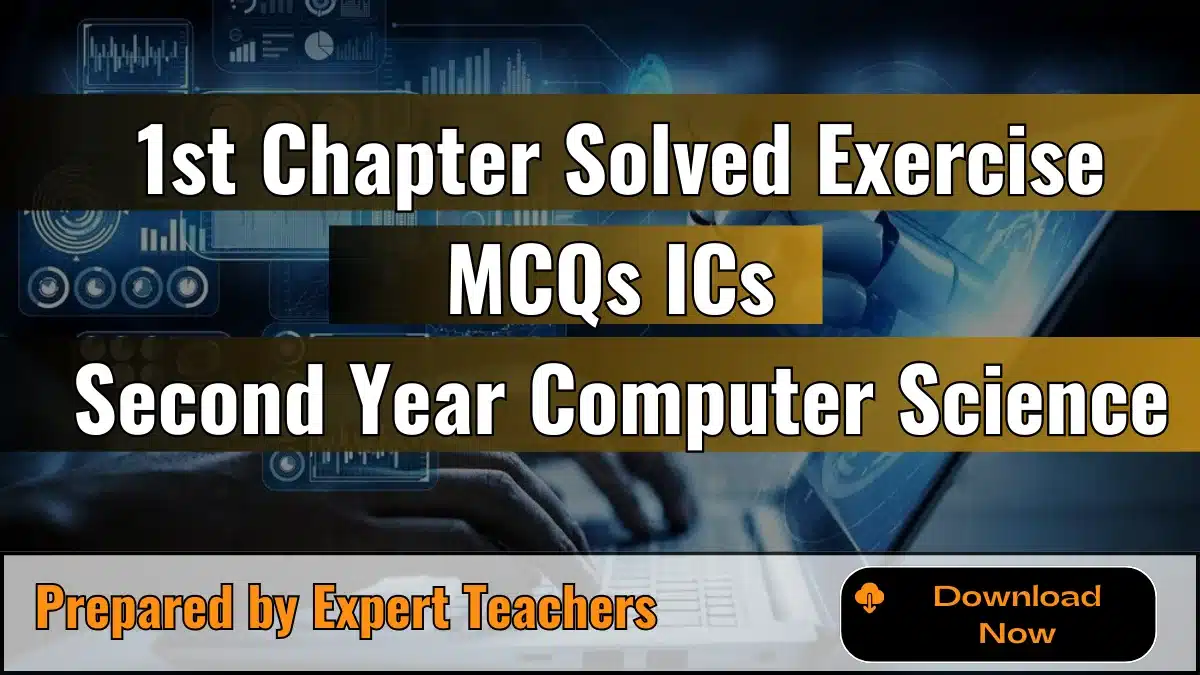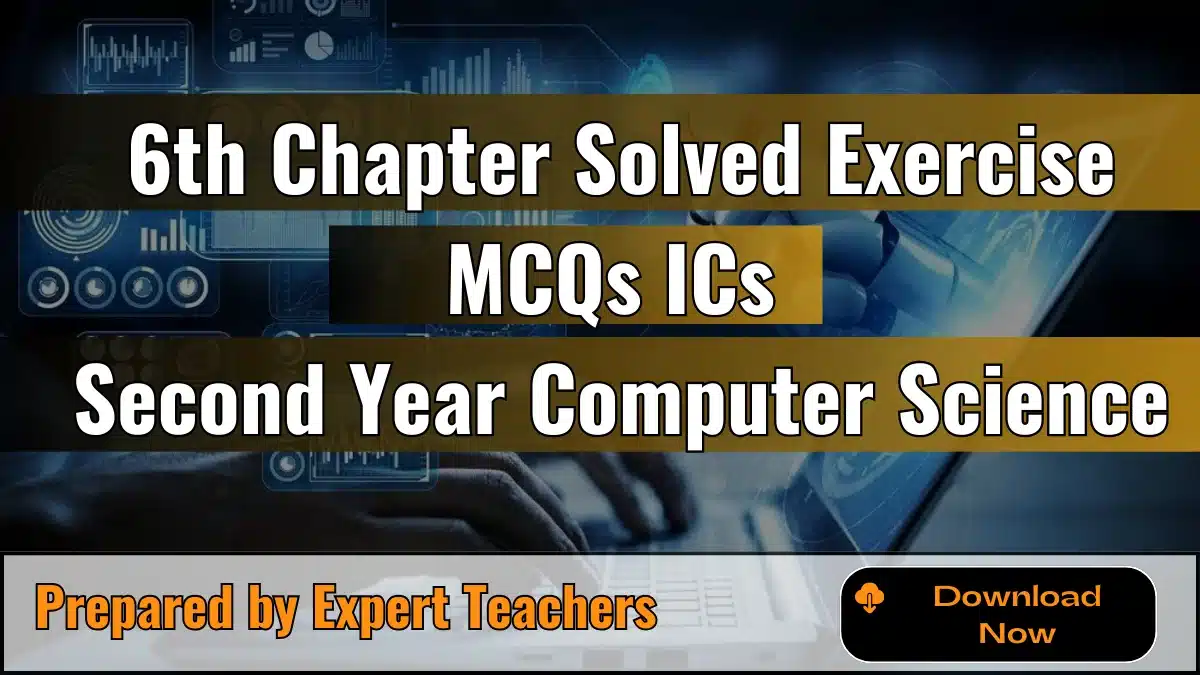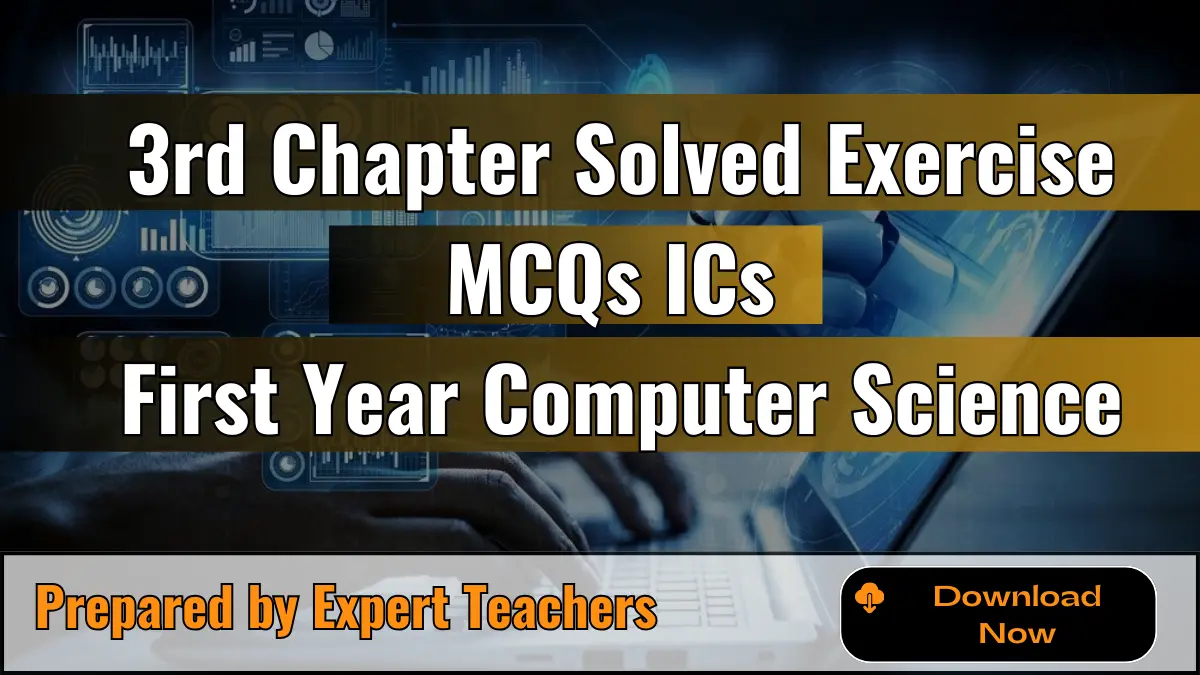1st Year Computer Chapter 2 MCQs and Solved Exercise
Looking for the best way to prepare for your 1st Year Computer Science exams? Our 1st Year Computer Chapter 2 MCQs with Answer on Information Networks are designed to give you the edge you need. These MCQs of Chapter 2, Information Networks, are specifically crafted for 11th Class Computer Science students to help you strengthen your understanding of key networking concepts.
Each question comes with a detailed answer, which makes it easier to understand complex topics and improve your exam performance. Whether you’re tackling practice tests or revising the chapter, our 11th Class Computer Science Chapter 2 MCQs with Answers will guide you through the critical points of the chapter.
With these MCQs, you’ll be better equipped for both your school exams and a deeper understanding of Information Networks. Don’t miss out on these essential practice questions – the perfect resource for Class 11 students aiming for top marks.
Check MCQs of ICS First Year Computer Science
1st Year Computer Chapter 2 Solved Exercise MCQs with Answers
1. A LAN is a combination of
(a) Network adapter cards
(c) LAN application software
(b) LAN cables
(d) All of above
Explanation: A Local Area Network (LAN) typically consists of network adapter cards, LAN cables, and LAN application software to enable communication between devices within a limited geographical area.
2. What layer of OSI model does data compression
(a) Network
(b) Presentation
(c) Data Link
(d) Physical
Explanation: The Presentation layer of the OSI model handles data compression, encryption, and decryption to ensure data is transmitted efficiently and securely.
3. Cabling on a linear bus topology can be extended using which of following?
(a) Terminator
(b) Barrel connector
(c) Network adapter card
(d) Medium attachment
Explanation: A barrel connector is used to join two cables together in a linear bus topology, allowing for extension of the network.
4. The Media Access Control sub layer resides in which layer?
(a) Physical
(b) Data link
(c) Network
(d) Transport
Explanation: The Media Access Control (MAC) sublayer is part of the Data Link layer, responsible for managing access to the physical medium.
5. FDDI is a
(a) Ring network
(b) Star network
(c) Mesh network
(d) Bus network
Explanation: Fiber Distributed Data Interface (FDDI) is a high-speed ring network topology.
6. How many pairs of computers can simultaneously communicate on Ethernet LAN?
(a) 1
(b) 2
(c) 3
(d) Multiple
Explanation: Ethernet LANs can support multiple pairs of computers communicating simultaneously using a carrier sense multiple access with collision detection (CSMA/CD) protocol.
7. One or more computers connected to a hub computer is a
(a) Ring network
(b) Node
(c) Information utility
(d) Star network
Explanation: A star network topology has a central hub, and all other devices are connected directly to it.
8. Project 802 defines standards for which layers of the OSI model?
(a) Application and presentation layers
(b) Physical and Data Link layers
(c) Transport and Network layers
(d) Network and Data Link layers
Explanation: Project 802 primarily focuses on defining standards for the Physical and Data Link layers of the OSI model.
9. Terminal is a
(a) Device to give power supply to computer
(b) Point at which data enters or leaves the computer
(c) The last instruction in a program
(d) Any input/output device
Explanation: Any input/output device is a general term referring to any hardware component that allows a computer to interact with the outside world.
10. Software to peruse the internet
(a) Gateway
(b) EFT
(c) Browser
(d) Teleconferencing
Explanation: A web browser is software used to access and view information on the internet. A web browser is software used to access and view information on the internet.
Solved MCQs for 11th Class Computer Science Chapter 2
1. Which of the following is NOT a category of network?
(a) WAN
(b) LAN
(c) MAN
(d) NAN
Explanation: While LAN, WAN, and MAN are standard network categories, NAN (Nano Area Network) is not a commonly recognized or standardized category.
2. A lab with twenty computers and a laser printer is an example of a:
(a) Limited area network
(b) Line area network
(c) Local area network
(d) Little area network
Explanation: A lab with interconnected computers and peripherals within a confined space is a typical example of a Local Area Network (LAN).
3. NIC stands for:
(a) Network Internal Card
(b) Newer Industrial Computer
(c) Networking Internet Connection
(d) Network Interface card
Explanation: NIC is the abbreviation for Network Interface Card, a hardware component that allows a computer to connect to a network.
4. Which problem occurs when two workstations on a shared Ethernet try to access the LAN at the same time?
(a) Termination
(b) Deadlock
(c) Collision
(d) Accident
Explanation: In a shared Ethernet environment, if two or more devices transmit data simultaneously, it results in a collision, where the signals interfere with each other.
5. The primary difference between a LAN and a WAN is:
(a) Number of software available
(b) Distance
(c) The variety of hardware devices
(d) Number of hardware devices
Explanation: The fundamental difference between a LAN and a WAN is the geographical area they cover. LANs cover smaller areas, while WANs cover much larger distances.
6. LAN stands for:
(a) Local Area Nodes
(b) Land Area Network
(c) Local Area Network)
(d) Linked Area Network
Explanation: LAN is the acronym for Local Area Network.
7. Which network covers a large area?
(a) LAN
(b) WAN
(c) MAN
(d) PAN
Explanation: A WAN (Wide Area Network) is designed to cover a broad geographical area.
8. Which of the following is a communications device?
(a) Router
(b) USB
(c) UTP
(d) Ethernet
Explanation: A router is a networking device that forwards data packets between computer networks.
9. A network that covers a limited geographic distance such as an office is called:
(a) NAN (Nano Area Network)
(b) MAN (Metropolitan Area Network)
(c) LAN (Local Area Network)
(d) WAN (Wide Area Network)
Explanation: A LAN (Local Area Network) is designed for a limited geographic area, like an office building.
10. Mobile phone (Cellular) systems often use:
(a) LAN
(b) WAN
(c) MAN
(d) GAN
Explanation: Mobile phone (cellular) systems utilize Wide Area Network (WAN) technologies to provide connectivity over large geographical areas.
11. Defacto means:
(a) By nature
(b) By fact
(c) By law
(d) By luck
Explanation: De facto standards are those that have become widely accepted and used in practice, often due to popularity or market dominance, rather than formal approval.
12. In a typical LAN, each computer on the network is connected through:
(a) Cables
(b) Satellites
(c) Microwaves
(d) Phone
Explanation: In most traditional LANs, computers and other devices are connected using physical cables like Ethernet cables.
13. How many types of network standards are there?
(a) 2
(b) 4
(c) 6
(d) 8
Explanation: There are generally considered to be four main types of network standards based on their formalization: De facto standards, De jure standards, Proprietary standards, and Open standards.
14. A network that covers a large geographic distance such as a country is called a:
(a) PAN
(b) MAN
(c) LAN
(d) WAN
Explanation: A WAN (Wide Area Network) spans a large geographical area, potentially covering cities, states, or even countries.
15. LAN does not use:
(a) Twisted pair cable
(b) Fiber optic cable
(c) Telephone line
(d) Coaxial cable
Explanation: While telephone lines can be used for dial-up internet access, they are not the primary medium for connecting devices within a Local Area Network (LAN). LANs typically use twisted pair, fiber optic, or coaxial cables.
16. What type of network is the Internet?
(a) LAN
(b) MAN
(c) WAN
(d) PAN
Explanation: The Internet is the largest example of a Wide Area Network (WAN), connecting billions of devices across the globe.
17. NIC allows direct connection to:
(a) Monitor
(b) Network
(c) Printer
(d) Modem
Explanation: A Network Interface Card (NIC) provides the physical connection point between a computer and the network medium (e.g., Ethernet cable).
18. Dejure means:
(a) By nature
(b) By fact
(c) By law
(d) By luck
Explanation: De jure standards are formally established and approved by recognized standards organizations.
19. The communication across WAN occurs using:
(a) Microwave
(b) Telephone line
(c) Satellite link
(d) Any of the above
Explanation: WANs utilize various communication technologies to connect networks over large distances, including microwave, telephone lines, and satellite links.
20. In WAN, the communication software that allows a personal computer to appear as a terminal is called:
(a) Electronic mail software
(b) Teleconferencing software
(c) Terminal emulation software
(d) Bulletin board system
Explanation: Terminal emulation software allows a personal computer to mimic the functionality of a terminal, enabling it to connect and interact with remote systems over a WAN.
21. Which type of network covers a small area?
(a) LAN (Local Area Network)
(b) WAN (Wide Area Network)
(c) MAN (Metropolitan Area Network)
(d) NAN (Nano Area Network)
Explanation: A LAN (Local Area Network) connects devices within a limited geographical area, such as an office, home, or school.
22. LAN stands for:
(a) Local Area Nodes
(b) Land Area Network
(c) Local Area Network)
(d) Linked Area Network
Explanation: LAN is the acronym for Local Area Network.
23. Another name for main memory is:
(a) Secondary memory
(b) Permanent memory
(c) Tape Storage
(d) Primary storage
Explanation: Main memory, where the computer actively stores data and instructions for the CPU, is also known as primary storage or RAM.
24. A major category of software is:
(a) Application and design
(b) Application and system
(c) System and design
(d) System and development
Explanation: Software is broadly categorized into two main types: system software (which manages the computer’s hardware and provides a platform for application software) and application software (which is designed to perform specific tasks for users).
25. The electronic circuit that executes computer instructions is called a(n):
(a) Monitor
(b) Hard disk
(c) Keyboard
(d) CPU
Explanation: The Central Processing Unit (CPU) is the core of the computer that fetches, decodes, and executes instructions.
26. Step-by-step instructions that run the computer is called:
(a) Hardware
(b) Procedure
(c) Calculation
(d) Software
Explanation: Software consists of sets of instructions, or programs, that tell the computer hardware what to do and how to perform tasks.
27. Printers and monitors are common forms of:
(a) Input devices
(b) Output devices
(c) Storage devices
(d) Processing devices
Explanation: Printers produce hard copies of information, and monitors display visual output, making them output devices.
28. CPU stands for:
(a) Central Processing Unit
(b) Central Product Unit
(c) Computing Program Usage
(d) Central Programming Unit
Explanation: CPU is the abbreviation for Central Processing Unit, which is the main processing unit of a computer.
29. Hardware is best described as:
(a) Physical parts
(b) Printed copy file
(c) Logical part
(d) Program
Explanation: Hardware encompasses the physical and tangible components of a computer system.
30. A computer is a combination of:
(a) Software
(b) Hardware
(c) Both a and b
(d) Knowledge
Explanation: A functional computer system requires both hardware (the physical components) and software (the instructions that run on the hardware) to operate.







Leave a Reply